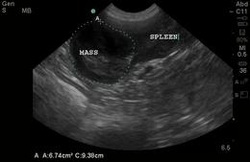What is Ultrasound?

Liver Cyst
Most people probably think of pregnancy and fuzzy grey images when they hear the word "ultrasound", but this technology has other important uses in human and veterinary medicine. Ultrasound is a safe, non-invasive tool that uses high-frequency sound waves, not radiation, to get clear pictures of soft tissue that do not show up well on x-ray. Because ultrasound images are captured in real-time, they can show the structure and movement of the body's internal organs, as well as blood flowing through blood vessels. Some of the organs that can be examined with ultrasound include the heart, liver, pancreas, kidneys, spleen, bladder, and gallbladder.
Source: Radiological Society of North America (www.radiologyinfo.org)
Source: Radiological Society of North America (www.radiologyinfo.org)
Uses of Veterinary Ultrasound

Tumor in Spleen
Veterinary ultrasound is used in many of the same circumstances that call for the use of ultrasound on humans. It can be a useful diagnostic tool, and it can also be used to monitor ongoing conditions. In some circumstances, it may be necessary to use veterinary ultrasound because animals cannot communicate with humans about their symptoms
One of the most common reasons for a veterinarian to use ultrasound is as an aid to diagnosis. For example, if a male cat is brought in by an owner who claims that the cat is having difficulty urinating, the veterinarian might use ultrasound to check for an obstruction in the bladder or urethra. Ultrasound can also be used to examine suspicious masses and other findings which occur during a manual exam. It can be used in emergency settings to look for serious medical problems such as internal organs damaged in a collision.
A clinic may also use veterinary ultrasound to monitor an ongoing condition. Ultrasound can also be used to monitor the progress of liver and kidney disease, along with any treatment approaches, just as it is in humans. Guided by the image from an ultrasound, a veterinarian can take a biopsy from a mass or cyst without having to do surgery. Since the organs can be seen in real-time as they are functioning, veterinarians can determine if they are functioning properly without the need for invasive procedures.
Sources: www.wisegeek.com and www.vetinfo.com
One of the most common reasons for a veterinarian to use ultrasound is as an aid to diagnosis. For example, if a male cat is brought in by an owner who claims that the cat is having difficulty urinating, the veterinarian might use ultrasound to check for an obstruction in the bladder or urethra. Ultrasound can also be used to examine suspicious masses and other findings which occur during a manual exam. It can be used in emergency settings to look for serious medical problems such as internal organs damaged in a collision.
A clinic may also use veterinary ultrasound to monitor an ongoing condition. Ultrasound can also be used to monitor the progress of liver and kidney disease, along with any treatment approaches, just as it is in humans. Guided by the image from an ultrasound, a veterinarian can take a biopsy from a mass or cyst without having to do surgery. Since the organs can be seen in real-time as they are functioning, veterinarians can determine if they are functioning properly without the need for invasive procedures.
Sources: www.wisegeek.com and www.vetinfo.com
